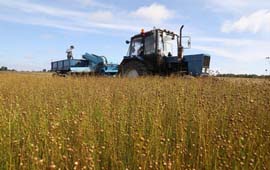On the world markets, flax is perhaps one of the main crops, which is used not only in industry, but also for farm needs.
If initially China was considered the main place for the cultivation of this crop, then in the 21st century the situation has changed, and the Celestial Empire is no longer so actively involved in this agriculture. But on the other hand, the initiative to grow flax was intercepted by the EU countries, which today rightfully occupy one of the leading places in the cultivation of this crop. By the way, it is in Europe that up to 80% of the seeds of this crop are produced today.

Not only yarn and fabric are obtained from flax, but also used for animal feed, as well as raw material for the production of vegetable oil. For this, European countries have all the necessary capacities, which makes these countries leaders in this industry.
What factors affect the yield of flax
In recent years, agrarians have begun to grow this crop more and more actively, since its yield is quite good, and the plant itself easily tolerates adverse weather conditions. In particular, flax is resistant to spring frosts, shedding of seeds and lodging, and the technology of its cultivation does not provide for the use of insecticides. In addition, this crop can grow on any type of soil and does not require fertilization to grow. And the possibilities of flax as an insurance crop for replanting winter crops only increases its attractiveness for farmers. In addition, the yield of this crop is often even higher than the yield of sunflower, and therefore many farmers decide to grow only flax, abandoning the sunflower. This is especially the case for farmers in EU countries, where there is all the capacity for this.

The only condition required for the growth of this plant is a sufficient, but not excessive amount of moisture, and with this, the farmers in 2020 had real difficulties. After all, even such a non-moisture-loving culture as flax was influenced by the dry period, which was especially brutal in 2020.
Flax yield in 2020
Since 2020 was distinguished not only by the coronavirus pandemic, but also by an unprecedented drought (and in all countries), the yield of many crops this year was not at the highest level. The need to supply seeds of various plants has increased, but only not all farmers have managed to get a sufficient amount of harvest to cover the needs of the market. According to statistics, in the EU, the yield of flax has been declining for several years due to unfavorable weather conditions. Oil World experts add that at the same time, global production of flax seeds in 2020 increased by 2.95 million tons, despite the effects of the drought. And the yield, in turn, will remain at a level of at least 10 t / ha. In order to export flax, especially to those countries that could not boast of good yields due to drought, producers will need to comply with the requirements adopted in the Customs Union, which can be found on the organization’s official website.






